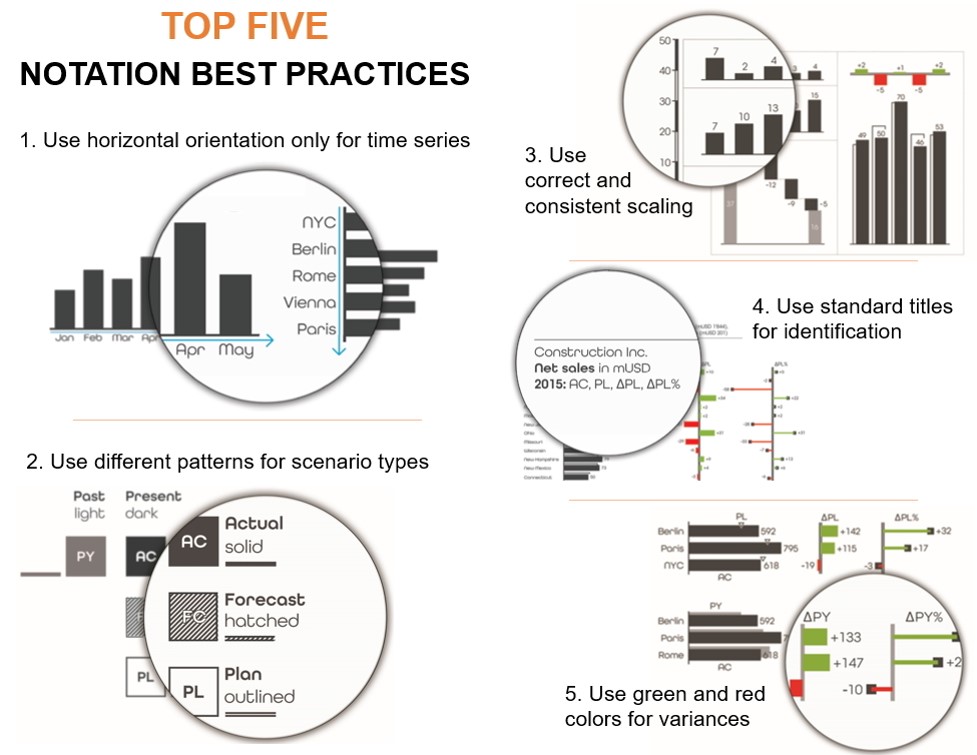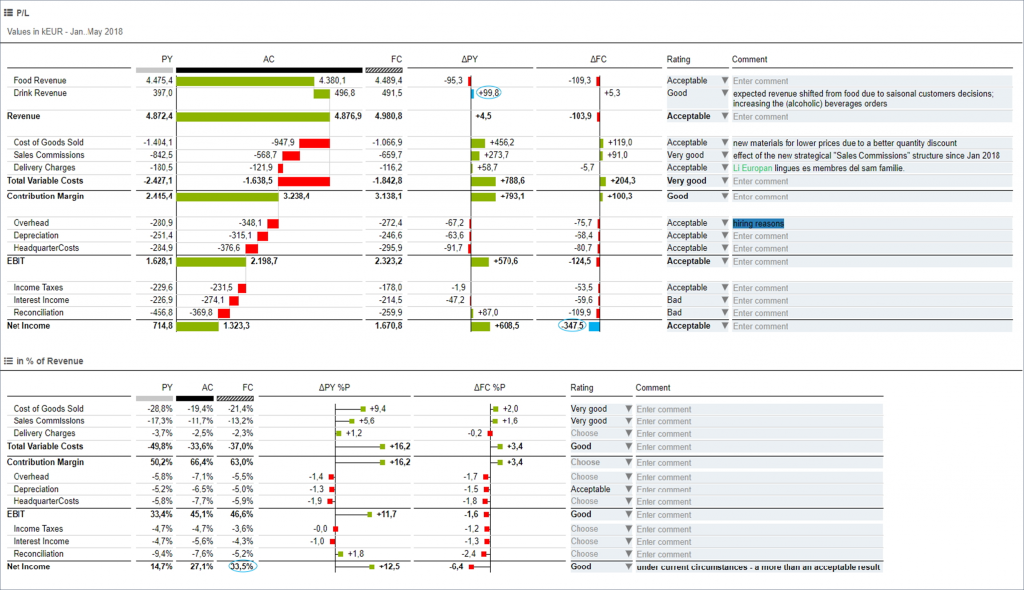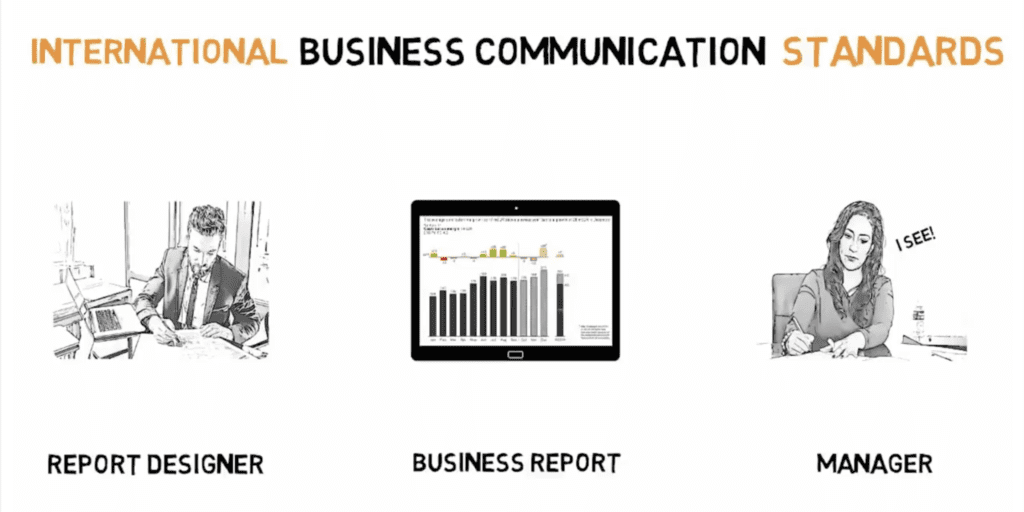Depending on the size of a business, the information flow can become overwhelming, and just the concept of streamlining data-related processes sounds intimidating. However, standardizing these processes will not only make things easier for employees and save them time, but it will also provide the business with a competitive advantage.
Doing so helps department managers to have near-instant access to vital information.
In a nutshell, standardized reporting helps businesses to:
- use a unified communication language across departments,
- understand and examine data efficiently – day in and day out,
- adjust its methods in response to changing market conditions and client needs,
- gain a competitive edge in the market, and
- provide its customers with a better experience.
The International Business Communication Standards (IBCS®) are an obvious choice for all companies seeking to streamline data reporting and data collaboration processes.
Not only does IBCS® simplify reports for every decision-maker involved, but also for everyone in the organization, which is vital for businesses reliant on high communication standards.
Let’s dive deeper into IBCS® and how it can transform a business.

What is IBCS®?
Many organizations suffer from the same problem – a plethora of different-looking reports which are hard to understand. This is due to the fact that report design is dictated by the creators’ own preferences and the features of the software in use, rather than by universally accepted standards.
IBCS® can be described as a unified language, graphs, and presentations that make business communication clear and straightforward. It is similar to how composers know what notes to use in a music sheet or how architects know exactly which metrics to use in their sketches so that everyone in the world can understand their work.
“If we had a standardized notation for business communication as there are for many other disciplines such as architecture, engineering, or music, then ‘same things’ would consistently look the same. The International Business Communication Standards (IBCS) is a Wikipedia-like Creative Commons project trying to define such a standardized notation for reports.”
Dr. Jürgen Faisst, Managing Director, IBCS Institute

Transform Any Business With IBCS®
The most significant advantages of implementing IBCS® are standardized reporting and accelerated business decision-making with data as its primary navigation tool.
Here are several other significant benefits of using IBCS.
1. Globally renowned standard of communication.
IBCS® is used by some of the most prominent organizations in the world. It is a tried and tested communication standard founded on simplicity, usability, and actionability. In a nutshell, the ultimate goal of IBCS® is to make every report understandable at a glance.
IBCS advises focusing on message delivery rather than just delivering raw data, standardizing labeling, ensuring adequate scaling, using appropriate chart types, and unifying the visual design of common report elements such as actual and planned data, variations, and all types of highlighting.
2. Establishing clarity of information – everywhere.
Another significant benefit of using IBCS® is clear business communications across all departments. Suppose four people are in charge of preparing reports in a large enterprise, and they do not use a unified standard. In that case, the result will undoubtedly be an insufficient basis for decision-making.
Standards make business communication as clear as a green traffic light. With IBCS®, all reports become transparent so that making decisions is only a matter of formality.
3. Simplifying and decluttering data reports.
The essence of IBCS® standards is described in the word SUCCESS – their main principles.
SAY
Get across the message necessary for making a decision.
Reports are frequently just data collections with no discernible message for the recipient. This is also true for the majority of presentations. With IBCS, the main aim is to send a certain message across instead of just presenting plain data.
UNIFY
Use simplified presentations that display unified and clearly recognizable data.
To help the reader visually identify between present, planned, or predicted numbers and the same information from earlier periods, use a consistent color notation.
Once such a notation system is in place, the reader’s eye is led to the desired values and the information displayed is intuitively processed. This saves the reader time by eliminating the time-consuming operation of matching the color notation to a legend.
CONDENSE
Condense information in one place so that comparisons can be made at a glance.
For example, it is recommended to condense information to a single page so that readers can quickly gain a complete overview of the business situation. Contrary to the common conception, this will not overwhelm the report’s reader, and the eye will explore the report very efficiently. Only truly relevant data are analyzed with focus.
CHECK
Ensure visual integrity and correctness to show the state of matters at a glance.
Present the facts honestly and objectively using uniform scaling in order not to manipulate the reader visually. It should really be a matter of common sense to design visualizations as true to reality as possible. Yet axes are frequently abbreviated or differently scaled, and these kinds of manipulation often lead to errors.
EXPRESS
Use proper visualization and standards that are consistent in all reports and presentations.
Choosing the correct visualization for the data structure and analysis goal is incredibly important. This begins with the proper layout of diagrams and continues with the expansion of deviation diagrams. Correctly expressing the data in this way improves analytical performance.
SIMPLIFY
Avoid clutter and aim for clarity, so the viewers don’t have to think about the meaning of the data presented.
Avoiding distracting design elements such as logos and colors is recommended in order to accelerate the conveyance of information. Colorful diagrams may look aesthetically pleasing but disrupt perception. Readers often manage much better with the (often dull-looking) IBCS notation.
STRUCTURE
Structure content so that equal is compared with equal.
Reports and presentations frequently lack a logical structure. In corporate communications, overlap and incompleteness obstruct comprehension. Therefore, it is important that all facts and information are compared with their equal counterparts.

4. Accelerating business decision-making.
When decision-makers are presented with simplified, decluttered, and action-ready reports, the entire decision-making process is carried out much faster. In addition, being able to make decisions that are backed by precise data presents a massive relief for executive decision-makers.
“Imagine you are looking at a business proposition that is simple, clear and unambiguous, full of accurate and applicable data.” That’s what IBCS® feels like in action. It enables faster, more precise, and better business decisions in any given moment, especially long-term.
5. Increasing confidence in business decisions.
Businesses need to make decisions based on facts. But without standardized facts, every decision is based on emotions and what feels right at that moment. With IBCS®, a company can confidently make decisions, knowing that each decision is based on facts, business data, and actionable information.

How IBCS Can Help You Cut Meeting Times in Half
One of the most significant benefits of using IBCS (so significant that it deserves its own section) is that it can help organizations significantly save time.
Here are a few real-life examples.
1. Visualization Transformation 101 Webinar
Dr. Jürgen Faisst met hundreds of CFOs during his webinar on “Visualization Transformation 101 – the best practice to maximize visual impact” for the Generation CFO Bootcamp in September 2021.
More than 70% of CFOs said:
You can save 50% of the time using consistent IBCS notation for reports and dashboards.
2. IMA’s Strategic Finance Magazin
Maurice Verhagen, Global Head of Insights & Analytics at Philips, interviewed in 2016 by IMA’s Strategic Finance Magazine, pointed out:
“First and foremost, the consumer of the report gets to the essence of the information much faster, which helps to shorten our time to make decisions.”
3. QIAGEN
QIAGEN is the world’s leading provider of comprehensive molecular analysis solutions for biological samples.
Daniel Grünebaum, Senior Director, Controlling, QIAGEN GmbH, comments that:
“The efficiency of reporting has increased significantly.”
He estimates the time savings to be up to 70%, thanks to IBCS.
Does IBCS Really Work? There is Scientific Proof It Does!
A study was carried out by Johannes Freyer, Timo Linde, Arne-Kristian Schulz, Dirk U. Proff to test the efficiency of IBCS. This study aimed to measure the effects of the IBCS rules on reading time and decision-making quality. According to the study results, the rules were able to deliver on their promise.
The IBCS standards increase the speed of analyses by 46% and the accuracy of decisions by 61%.
The rule areas SIMPLIFY and CONDENSE primarily influence processing time – and are thus ‘time savers’. UNIFY and CHECK, however, are the ‘quality managers’, as they help readers avoid errors.
IBCS Testimonials
“Information and decision-making can be greatly improved using International Business Communication Standards (IBCS®). These guidelines help standardize presentations to improve comprehension and decision-making at a lower cost and in less time. They are an essential tool for any organization that pursues excellence in all it does.”
Oriol Amat, Professor at Universitat Pompeu Fabra and President of the Catalan Association of Accounting and Management (ACCID)
“IBCS® has been a great accelerator for us to take our business insights to the next level.”
Maurice Verhagen, Head of Reporting Services at PHILIPS
“With the change in reporting based on the design standards of Prof. Dr. Hichert, the Bundesagentur für Arbeit (German Federal Employment Agency) is taking an effect-oriented approach. Transparency and benchmarking criteria are given top priority so that we can track every cent spent and evaluate every employment measure taken.”
Dr. rer. pol. h. c. Frank-J. Weise, German Federal Employment Agency
“The standards proposed by IBCS are great! The next big trend in Business Intelligence, will be driven by IBCS for sure. I think it is already started…”
Shankar Rajkumar, Lead of Project Management Office, Arcolab, India
Conclusion
IBCS-compliant reports are designed so that the reader can use the strengths of the human eye when analyzing them while simultaneously sparing the limited ‚working memory’ of the brain. The report is easier to take in and readers feel more secure in their analysis.
One of the easiest ways to implement IBCS reporting is with TRUECHART.
TRUECHART is a scalable, enterprise-class solution that integrates with your preferred BI and Analytics tools (QlikView, Qlik Sense, Power BI, and any platform with an API).
TRUECHART enables faster, better, more-informed decision-making across your entire organization by offering functionally to fully enabling IBCS® in any corporate environment.
If you want to take your organization to the next level and outperform your competitors, start focusing on the essential aspect of your business – your data. And, with TRUECHART and IBCS, you’ll be able to make the most out of it!
Book your TRUECHART demo today.
Stay up-to-date with TRUECHART. Follow us on LinkedIn.
